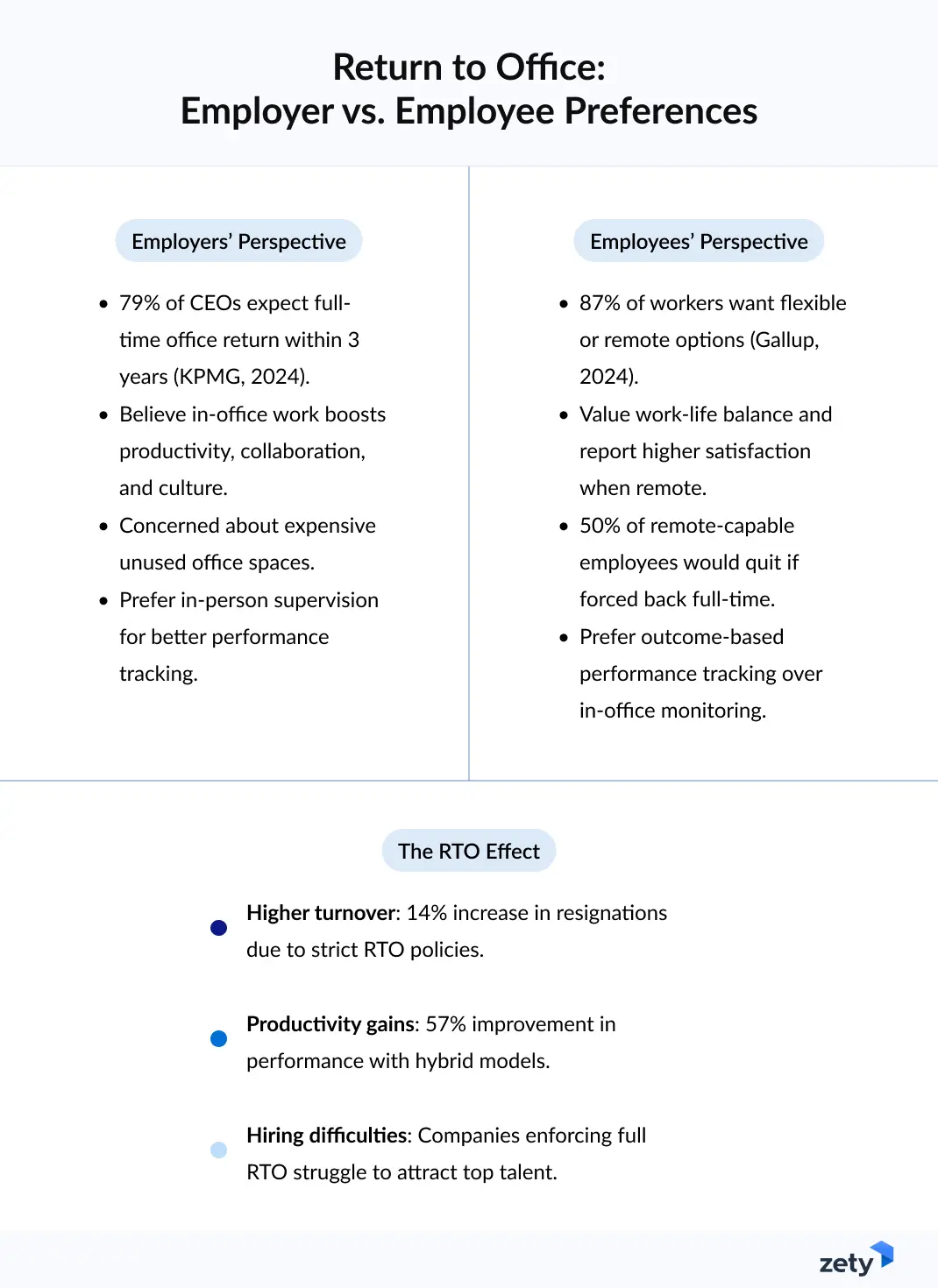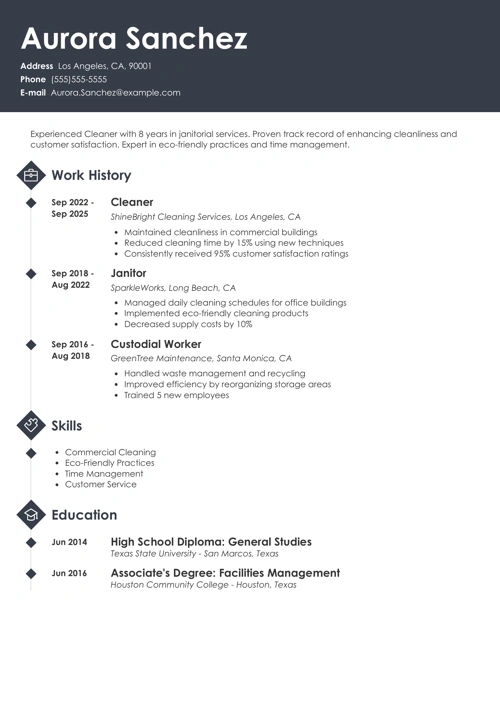During the pandemic, remote work became the norm, changing the way people approach their jobs. As companies push for a return to the office (RTO), there’s a visible divide between employers enforcing in-office mandates and employees pushing back, scared of losing flexibility and work-life balance. This clash impacts productivity, talent retention, and company culture.
In this article, I explore the RTO mismatch, its impact, and how businesses and employees can find common ground for a solution that works for both sides.
The Current State of Return-to-Office Policies
In 2023 and 2024, major corporations—Amazon, JPMorgan, Disney, Starbucks, X (formerly Twitter), and Zoom—have mandated employees return to offices at least three to four days a week, if not full-time. A 2024 KPMG survey revealed that 79% of global CEOs expect their staff to work in the office full-time within the next three years, a significant increase from 34% earlier in the year.
Yet, surveys indicate that 87% of employees want flexibility, with many even willing to change jobs to retain remote options. This gap shows a significant change in work preferences and values versus corporate expectations. Gallup reports that more than half of remote workers say they would actively look for another job if forced back full-time. Recent resignations in tech, finance, and consulting suggest rigid RTO policies may be driving top talent away.
Here are the reasons given by major companies for enforcing return-to-office (RTO) policies:
- Amazon:CEO Andy Jassy emphasized the value of in-person collaboration, reinstating pre-pandemic office expectations.
- Disney: Bob Iger, Disney’s CEO, mandated four in-office days per week, highlighting the necessity of physical presence in creative industries.
- JPMorgan: Jamie Dimon, CEO of JPMorgan, has been a strong critic of remote work, arguing that it reduces productivity, stifles collaboration, and weakens company culture.
- Starbucks: CEO Brian Niccol and other executives believe that an office presence helps reinforce Starbucks’ mission, values, and overall workplace culture.
- X (formerly Twitter): Elon Musk enforced a strict in-office policy, making full-time attendance mandatory; non-compliance is considered a resignation.
- Zoom: Despite being a remote work pioneer, Zoom now requires employees near corporate offices to attend work in person at least two days a week.
Even industries that once championed remote work, like tech, are now enforcing return-to-office policies. Companies like Zoom and X, despite thriving on digital collaboration, have tightened in-office policies, proving that even remote-first businesses recognize the value of physical presence.
Why Are Employers Pushing for RTO?
Many companies believe in-office work offers key benefits that remote setups can’t fully replicate. Here’s what’s driving their push for RTO:
1. Productivity and Collaboration
Employers argue that face-to-face interactions fuel innovation, spontaneous brainstorming, and more efficient problem-solving. They claim that remote work, while effective for individual tasks, hampers team synergy and spontaneous creativity.
Research from Stanford Graduate School of Business revealed that pairs working face-to-face generated 15% to 20% more ideas than those collaborating over Zoom, highlighting the creative advantages of in-person collaboration.
2. Company Culture and Team Relations
Leaders worry that continuous remote work is worsening workplace relationships and weakening company culture. They believe in-person mentorship and team bonding opportunities are key to developing a strong, cohesive workforce—especially for younger employees and new hires. A Gallup survey reported that only 28% of fully remote employees felt connected to their company's mission, marking a record low and indicating a decline in engagement.
3. Office Space Justification
With long-term leases and corporate headquarters that cost millions, companies feel pressured to bring employees back to justify these expenses. Empty office spaces translate to significant financial losses, making RTO as much an economic necessity as a cultural shift.
The Wall Street Journal highlighted that many companies are grappling with underutilized office spaces, prompting discussions on the necessity of return-to-office mandates to optimize expenditures.
4. Management Comfort & Visibility
Many managers pair physical presence with productivity. They believe employees work harder when physically monitored, despite growing evidence that productivity can thrive in remote or hybrid settings when performance is evaluated based on outcomes rather than presence.

Why Employees Resist Returning to the Office?
While companies push for a return to traditional office setups, employees are pushing back with compelling reasons of their own. The flexibility employees experienced during the pandemic has permanently transformed their expectations of work.
What are the key reasons employees resist returning to the office?
1. Work-Life Balance and Flexibility
Remote work has given employees greater control over their schedules, allowing them to balance work with personal life more effectively. Many workers are reluctant to give up the autonomy they’ve gained. A survey by Randstad revealed that 83% of workers now value work-life balance over pay, a shift attributed to experiences during the COVID-19 pandemic.
2. Increased Productivity and Focus
Numerous studies indicate that employees feel more productive when working from home. Fewer workplace distractions, more control over work environments, and reduced office politics contribute to a more focused workflow.
3. The Cost and Time of Commuting
Forcing employees back to the office means increased expenses for transportation, meals, and professional attire when needed. Many workers see this as an unnecessary cost, particularly when they have proven they can be equally—if not more—productive from home.
Research from Global Workplace Analytics indicates that hybrid employees who worked from home twice a week saved from $305 to $2,357 per year on travel, parking, food, and work clothes, based on average price data nationwide.
4. Health & Wellbeing Concerns
The pandemic heightened awareness of mental health, workplace stress, and the risks associated with commuting and office environments. Employees who prioritize their well-being argue that remote or hybrid work minimizes stress and contributes to a healthier work-life balance.
How the RTO Debate is Changing Work
The back-and-forth over RTO isn’t just about differing opinions—it’s already having real effects on both businesses and employees. Here’s how:
- Increased turnover and talent drain: Rigid RTO policies are driving employees to seek out more flexible employers. Industries like tech, finance, and consulting have already seen a series of resignations as skilled employees migrate toward companies that prioritize flexibility.
- Employee dissatisfaction & lower engagement: Forcing employees back into the office against their will risks disengagement, decreased motivation, and resentment—ultimately leading to reduced productivity rather than the intended improvement.
- Difficulty in hiring top talents: Top talent now prioritizes flexibility when choosing new roles. Companies demanding full-time office work may find it harder to attract top talent, risking a competitive disadvantage.
With strict RTO policies driving higher turnover, companies are left dealing with the costly cycle of hiring, onboarding, and training new employees. In the end, these expenses can outweigh the supposed benefits of bringing everyone back to the office.
Can Flexibility and Office Culture Coexist?
How can companies and employees find common ground in the RTO debate? The key is compromise—businesses need to balance flexibility with productivity while preserving a strong company culture. Here’s how:
- Embracing flexible work models: Hybrid work—where employees come in 2–3 days per week—is a strong compromise between full RTO and full remote work.
- Focusing on outcome-based performance metrics: Rather than tracking hours in-office, companies should focus on results and productivity-driven assessments.
- Reinventing office spaces for collaboration: To encourage voluntary office attendance, businesses should design office environments that foster networking, brainstorming, and social interactions.
- Including employee feedback in RTO decisions: Surveys and direct employee input can help companies tailor RTO policies that balance employer goals with employee needs.
Summary
The Great Mismatch highlights a deep divide in how work is perceived post-pandemic. Here’s a quick summary of what I’ve covered in the article:
- Variable preferences impacting work environments: While 79% of global CEOs anticipate a full-time office return within three years, 87% of employees prefer flexible work options, leading to increased turnover and workplace tensions.
- Negative consequences of rigid RTO policies: Companies enforcing strict return-to-office mandates have experienced a 14% increase in employee turnover, particularly among top talent.
- Benefits of hybrid work models: Organizations adopting hybrid work arrangements have seen a 57% improvement in workforce performance and productivity.
- Finding compromise is key for future prosperity: Companies need to balance operational needs with employee well-being. This way, they can position themselves for long-term success in the constantly evolving job market.
About Zety’s Editorial Process
This article has been reviewed by our editorial team to make sure it follows Zety's editorial guidelines. We’re committed to sharing our expertise and giving you trustworthy career advice tailored to your needs. High-quality content is what brings over 40 million readers to our site every year. But we don't stop there. Our team conducts original research to understand the job market better, and we pride ourselves on being quoted by top universities and prime media outlets from around the world.

